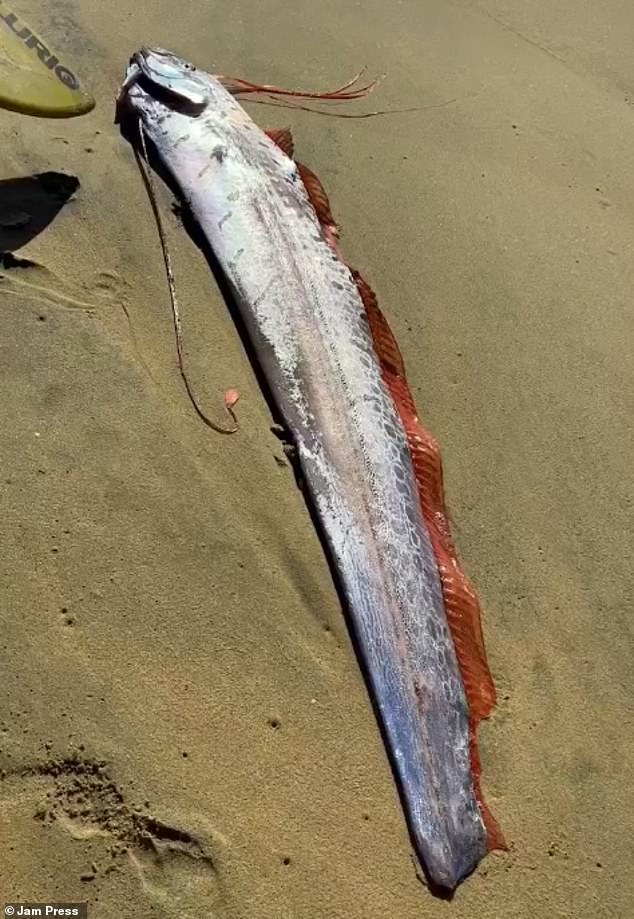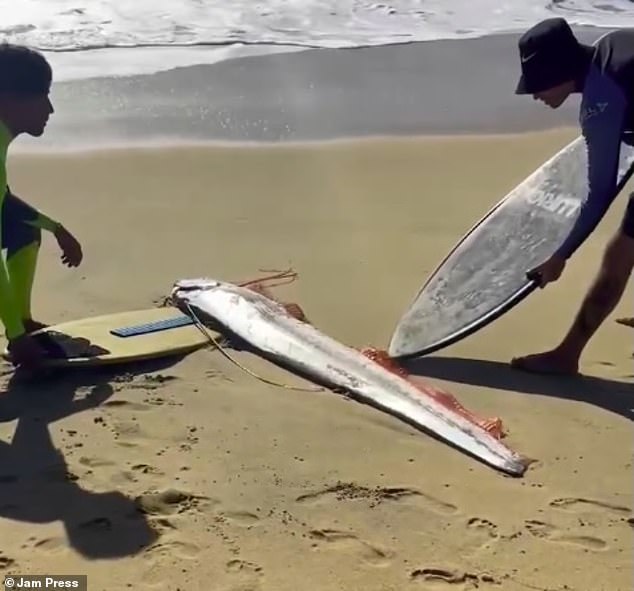A rarely seen ‘doomsday’ fish was found ashore on a Mexico beach, sparking fears of a looming disaster.
Surfers spotted the creature, known as an oarfish, on the southern tip of the Baja California Peninsula.
The massive fish, about as long as a surfboard, featured a silvery-blue body with a stunning red fin trailing down its back but had an injured tail.
They can measure up to 36 feet in length and weigh over 441 pounds.
Legend has it that the fish are harbingers of earthquakes and other natural disasters.
A local who witnessed the scene in Mexico said: ‘They say those fish appear when there is going to be a very strong tsunami.’
While scientists have not proven a correlation, 20 oarfishes washed up ashore months before Japan was hit with a devastating tsunami that left over 15,000 people dead and led to a 9.0 magnitude earthquake in March 2011.
While the fish in Mexico was the first to be seen in 2025, one was spotted in California a month before it was rocked by a 7.0 magnitude earthquake last year.

The young surfers quickly ran to the fish, scooped it up using their boards and moved it back into the ocean.
Due to their size and shape, oarfish resemble ‘sea serpents’ and are seen as a sign of things to come in Japanese mythology where it is known as ‘the messenger from the sea dragon god’s palace.’
The legend says that oarfish live under the islands of Japan, and they come to the surface to warn people about a coming earthquake.
But the creatures are found worldwide, living at depths ranging from 656 feet to 3,280 feet below the surface.
Their body is scaleless and the skin has a slimy, silvery protective coating known as guanine.
The Japanese myth was rekindled in 2011 after the Tōhoku earthquake and tsunami.
On March 11, a catastrophic 9.1 magnitude megathrust earthquake just 45 miles east of Japan rumbled for six minutes, pushing waves of up to 133 feet nearly 440 miles per hour as it hit the country.
The waves had enough energy to travel six miles inland, taking out critical infrastructure, homes and offices on the eastern coast.

More recently, an oarfish washed ashore in California last November.
Researchers at the Scripps Institution of Oceanography released pictures of a dead oarfish lying onshore of the Grandview Surf Beach in Encinitas.
Researchers at the Scripps Institution of Oceanography released pictures of a dead oarfish lying onshore of the Grandview Surf Beach in Encinitas.
And in December, the state was rocked by a major earthquake that triggered a tsunami warning.
The earthquake struck at 10.44am, 45 miles off the coast of Eureka, with an aftershock felt in San Francisco shortly afterwards.
The ensuing tsunami warning was blasted to Californians phones, telling them to seek higher ground immediately.
‘You are in danger!’ it warned. By 12pm PST, the tsunami warning had been canceled.
But the initial impact rocked households and churned waves in backyard swimming pools.
California is bisected by the San Andreas Fault, the boundary between the Pacific and North American tectonic plates, which is prone to earthquakes.
